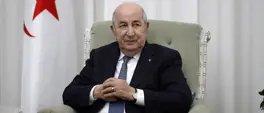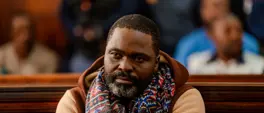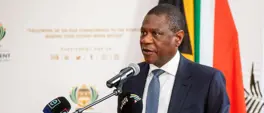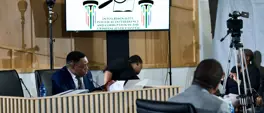MALAIKA MAHLATSI: Of bloated cabinets - A barometer of SA’s executive from 1994 to 2024 | Part 1
Malaika Mahlatsi
1 July 2024 | 5:45Several factors account for the growing executive in South Africa, the most obvious one being the rise of political clientelism, which became entrenched under Zuma and continues under Ramaphosa, writes Malaika Mahlatsi.
On Sunday night, the 30th of June 2024, President Cyril Ramaphosa announced his Cabinet and deputy minister appointments.
The announcement came after weeks of tense negotiations between the African National Congress (ANC) and the Democratic Alliance (DA), who are part of the Government of National Unity (GNU) that was established following the watershed general elections in which the ANC lost its majority for the first time in 30 years of South Africa’s democracy.
Just days before the Cabinet was announced, and as admitted by the federal council chairperson of the DA, Helen Zille, the negotiations came dangerously close to collapsing.
This was due in part to the insupportable demands of the DA which sought to undermine the GNU and the very laws of the land. After many discussions, the GNU executive was finally concluded and its announcement was welcome, if only for the uncertainty that it allayed in the market.
However, many analysts and political leaders, such as ActionSA’s Herman Mashaba, have raised concerns about the persistence of a bloated Cabinet and national executive.
In his address to the nation, Ramaphosa touched on the issue of a bloated executive, stating that prevailing political conditions demanded that he increase the size of the executive in order to accommodate members of the GNU and ensure fair representation.
The executive comprises of the president, deputy president, 32 ministers and 43 deputy ministers. In terms of party allocation, the ANC has 20 ministers and 35 deputy ministers; the DA has 6 ministers and 6 deputy ministers; the IFP has two ministers and an equal number of deputy ministers; the Freedom Front Plus, Pan Africanist Congress of Azania, GOOD and Patriotic Alliance have one minister each; and the United Democratic Movement and Al Jama-ah have one deputy minister each.
Both the president, Ramaphosa, and deputy president, Paul Mashatile, are from the ANC. The executive represents nine of the ten parties that are currently in the GNU. Rise Mzansi, which garnered two seats in the National Assembly, joined the GNU on the 22nd of June. However, it is not represented in Cabinet and does not have a deputy minister.
The size of the executive in the 7th administration is one of the biggest in the world. In fact, South Africa has one of the biggest cabinets in the world relative to the size of its population.
Even the United Kingdom, which has one of the biggest cabinets in the developed world, with a total of 31 ministers, has a smaller executive despite having roughly 7 million more people than us.
Countries such as Germany, the biggest economy in Europe and a country with a population of just over 83 million, more than 20 million people more than South Africa, has a Cabinet of just 16 federal ministers and the Chancellor.
Interestingly, the German Cabinet is also a coalition not too dissimilar to the GNU, comprising of ministers from the three dominant parties, namely, the Social Democratic Party (SDU), the Free Democratic Party (FDP), and the Greens.
The executive of South Africa has been growing since the first democratic administration of Nelson Mandela in 1994. The said executive, which was also a GNU, comprised of the president, two deputy presidents and 27 ministers, including Jay Naidoo, who served as a minister without portfolio.
It had 13 deputy ministers. By the end of its term, in 1999, only one deputy president remained. The Ministry of Land Affairs and Ministry of Agriculture were combined, while the Ministry of General Affairs was abolished. Naidoo’s term also ended in 1996.
Under Mbeki’s first administration, from 1999 to 2004, there was one president and one deputy president. There were 28 ministers – a slight increase from the previous administration. His second administration, from 2004 until his resignation in 2008, comprised of 26 ministers and had only 10 deputy ministers. The following administration, under Kgalema Motlanthe, lasted for just over a year. It also had 28 ministers, but increased deputy ministers from 10 to 19.
The significant increase in the national executive occurred under President Jacob Zuma. In his first Cabinet, from 2009 to 2014, there was a total of 34 ministers. The said executive had 28 deputy ministers – an increase of 9 from the previous administration. In Zuma’s second administration, from 2014 until his resignation in 2018, there were 35 ministers. The number of deputy ministers increased by 11 to 39.
Ramaphosa, who came in with promises to reduce the Cabinet, started his term in 2018 with 33 ministers. His second executive, formed in 2019 and dissolved on the 19th of June 2024, comprised of 30 ministers. This was largely due to the amalgamation of various portfolios, reducing the number of portfolios from 36 to 28.
Despite a decrease in portfolios, the number of deputy ministers in the sixth administration increased to 34. In the recently announced GNU, there are 11 more deputy ministers. This aligns to the 11 portfolios that now have two deputy ministers.
These portfolios include Cooperative Governance and Traditional Affairs (COGTA), Defence and Military Veterans, Higher Education, Police, the Presidency, Water and Sanitation, and several others.
Several factors account for the growing executive in South Africa. The most obvious one is the rise of political clientelism, which became entrenched under Zuma and continues under Ramaphosa.
Political clientelism is effectively the rewarding of one’s political allies through Cabinet and deputy ministry portfolios. It is done to insulate political leaders from opposing factions, particularly within their own organisations.
Under Zuma, factionalism in the ANC became entrenched, setting parameters for the isolation of mainly Mbeki supporters and the rise of political clientelism. Under Ramaphosa, who initially had to insulate himself from the once strong radical economic transformation (RET) faction, the same political clientelism persisted.
The second factor that accounts for a growing executive is the growing size of the South African population. In 1994, the population stood at 43 million. As of 2024, the population has increased to just over 61 million. While this is a factor, it is not a significant one, particularly when assessed against bigger populations globally.
The third factor that accounts for the growing executive is an increasingly sophisticated society and economy that necessitates evolving skills and expertise in what many refer to as a post-productivist economy.
Some of the portfolios in the Cabinet are new and a response to changing times. But there is a legitimate question of whether appointing ministers and deputy ministers in such portfolios, as opposed to increasing the capacity and human capital of the administration, is the best approach.
The second part of this article will analyse cabinets from some key countries in both the Global North and the Global South. It will assess whether a growing executive is an important instrument for bringing about meaningful change or a dangerous impediment to transformation and development.
Malaika is a researcher and geographer at the Institute for Pan African Thought and Conversation. She is a PhD in Geography candidate at the University of Bayreuth in Germany.
Get the whole picture 💡
Take a look at the topic timeline for all related articles.
















